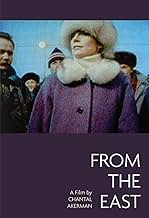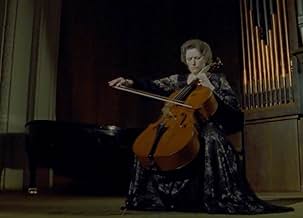D'Est
- 1993
- 1h 47m
IMDb RATING
7.2/10
1.1K
YOUR RATING
A look at life in Eastern Europe after the collapse of the Soviet Union.A look at life in Eastern Europe after the collapse of the Soviet Union.A look at life in Eastern Europe after the collapse of the Soviet Union.
- Director
- Writer
- Star
- Director
- Writer
- All cast & crew
- Production, box office & more at IMDbPro
Featured reviews
This 1993 film by Chantal Akerman resembles some of her best early experimental work from the 1970s, especially 'Hotel Monterey'. This is a truly non-narrative film. Just a series of images from across Russia; often slow, amazingly long tracking shots (probably made from a car, but somehow rock steady), intercut with some long stationary wide angle shots, and shots of people in rooms, clearly staged. There's no dialogue and almost no music, only the incidental sounds of the place being photographed.
The film is clearly a comment on how lost Russia was at that moment in history after communism fell – a lifetime of one ideology was suddenly gone, and nothing new had yet taking it's place. We see it in the faces - every person looks like they're waiting for something. The only problem for me was the length. At 110 minutes both images and ideas, terrific though they were, started to feel repetitive. That said, I'd gladly re-visit and see if a second viewing, knowing now what the style of the film is, would be easier to settle into, and get lost in.
The film is clearly a comment on how lost Russia was at that moment in history after communism fell – a lifetime of one ideology was suddenly gone, and nothing new had yet taking it's place. We see it in the faces - every person looks like they're waiting for something. The only problem for me was the length. At 110 minutes both images and ideas, terrific though they were, started to feel repetitive. That said, I'd gladly re-visit and see if a second viewing, knowing now what the style of the film is, would be easier to settle into, and get lost in.
Chantal Akerman's haunting masterwork is not for those looking for clearly drawn narratives and characters, but for those willing to commit two hours to observation and contemplation, D'EST could be an extremely rewarding experience. There are moments when the poetic minimalism of this perceptive film feels like epiphany, but passive viewers may walk away empty-handed. It could be described as an existential meditation on memory and endurance, and while that may not sound exactly riveting, D'EST is, nevertheless, film-making of the very highest order, a work of art expanding the boundaries of the language of cinema.
Personal "slideshow" album from the director's journey in Eastern Europe and Russia. Well executed; pictures are precisely framed by fixed camera with occasional dolly. (There is only one shot with panning, the shot in a big station) Because nothing happens in a landscape sequence during two hours, the piece is more suitable to be viewed in a gallery or in a public place than in a theater. Conceptually, it is reminiscent of Erik Satie's Furniture Music.
Finally... 20 years after being inspired by Michael Snow, Ackerman finally shoots something... Human?
It's just a good documentary, almost pure chronicle of the early 20th century.
The camera work - and I remind you that it has its roots in the film "Central Region" of 1971 - here finally takes shape into something fundamental. This is no longer just a structuralist misanthropic experiment, but a formalized filming style on the level of Dziga Vertov or Peter Hutton.
As a Russian, I can note the shocking size of the queue for public transport. And in general, everything is pretty gloomy after the collapse of the USSR: Square brutal stalls, a complete lack of foreign cars... In general, the chronicle is interesting.
9 out of 10.
It's just a good documentary, almost pure chronicle of the early 20th century.
The camera work - and I remind you that it has its roots in the film "Central Region" of 1971 - here finally takes shape into something fundamental. This is no longer just a structuralist misanthropic experiment, but a formalized filming style on the level of Dziga Vertov or Peter Hutton.
As a Russian, I can note the shocking size of the queue for public transport. And in general, everything is pretty gloomy after the collapse of the USSR: Square brutal stalls, a complete lack of foreign cars... In general, the chronicle is interesting.
9 out of 10.
Chantal Akerman's film is a sort of documentary of Eastern Europe and Russia after the Berlin Wall fell and Communism was basically abolished. You are shown beautifully filmed winter pictures in various countries with crowds of people waiting for buses and/or trains. Some scenes are quite effective: a long sequence in some train station, people dancing in some club. Most of the faces Akerman shows look unhappy. I have heard some Eastern Europeans say that they were at least secure under Communism but were left in the lurch when they had to immediately fend for themselves. I suppose that is Akerman's point. What bothered me most was that I had no idea where the filming was taking place. In what country or city where were the streetcars and snow covered roads? As a traveler, I found this quite frustrating. Occasionally you hear people shouting in some language but there is no translation.
Did you know
- ConnectionsFeatured in Women Make Film: A New Road Movie Through Cinema (2018)
- How long is From the East?Powered by Alexa
Details
- Release date
- Countries of origin
- Official site
- Language
- Also known as
- From the East
- Filming locations
- Production companies
- See more company credits at IMDbPro
Box office
- Gross US & Canada
- $8,540
- Opening weekend US & Canada
- $564
- Apr 17, 2016
- Gross worldwide
- $8,540
- Runtime1 hour 47 minutes
- Color
- Aspect ratio
- 1.37 : 1
Contribute to this page
Suggest an edit or add missing content









